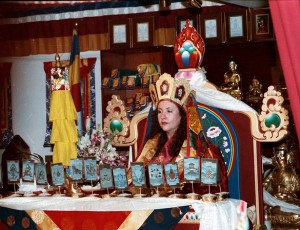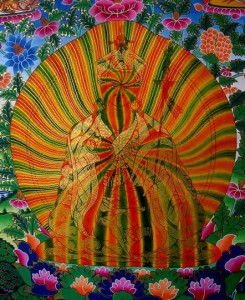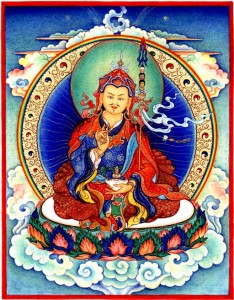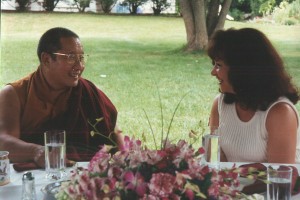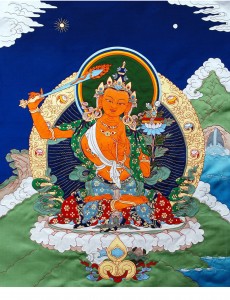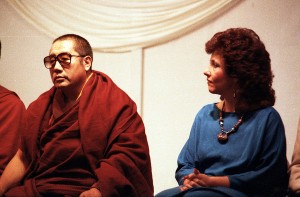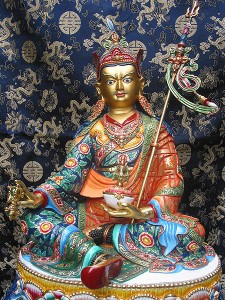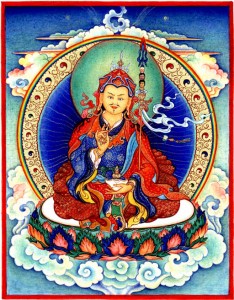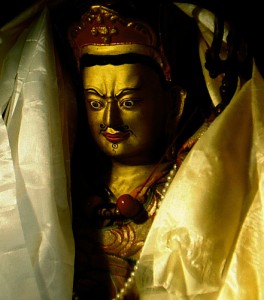The following is an excerpt from a teaching by Jetsunma Ahkon Lhamo called “The Guru is Your Diamond”
The Lama gives us not only a way to have single-pointed concentration, but the Lama also offers their own accomplishment. When one practices the Guru Yoga really deeply, whether it be in the Guru Yoga in Ngndro, or Shower of Blessings, or in any of the pujas that have Guru Rinpoche as the main focal point or Guru Rinpoche and consort as the main focal point, we should think thatthis is the way to practice Guru Yoga. And in each one of those practices, whichever it is, we understand nondual nature. That’s what we’re working on.
We see the arising from the nature of emptiness appearing in a real, but insubstantial gossamer-like light form, first as the seed syllable, and then as the Guru. We are telling ourselves our own story, because it is we also who have arisen from emptiness. It is our nature that is indeed also the seed syllable. Ultimately we are the same nature as the Guru. By the power of the Guru’s accomplishment, through their many lifetimes of amazing practice, many lifetimes of looking out after sentient beings and accomplishing the needs of sentient beings and liberating sentient beings, they offer themselves and their accomplishment in that way to be the very door to liberation. And so we should think of our teachers in that way—that we are in a burning house, no other way to get out except that one door. Boy, would you ever be devoted to that door. That door would be on your mind if your house were burning, and there were no other way to get out, wouldn’t it? And that’s how we should think. We should think that here we are in samsara. This is indeed the time of Kaliyuga. We have, at best, as many habitual tendencies guaranteed to bring us suffering as we do to bring us happiness. At best. 50/50. And that is so unusual. We tend to make ourselves more unhappy than we do happy. So we are in this burning house and we look to the teacher to provide the door to liberation.
So when we give rise to that devotion, it’s not to the person Guru. It’s not to that person. It doesn’t matter if you like what they’re wearing or how they smell or what they look like or how they walk or anything like that. It doesn’t matter. That’s just the stuff you do in regular life. So you can just sweep it over. Instead you think, “This one has appeared and will appear throughout time out of mind until all suffering has ended, until samsara is emptied, as the door to liberation. What kind of dope am I that I wouldn’t walk through it?” It’s that kind of fervent regard. Think of it that way—more than like-dislike, that kind of judgment, but rather, fervent regard.
We rely on the accomplishment of our teachers. If our teachers had not accomplished any Dharma, how would they be of any use to us? So we expect it of them and we rely on them to guide us in the way of Dharma. Sometimes it pisses us off. We’d rather go on vacation. We’d rather have a little more fun. I mean, it’s Sunday afternoon, isn’t it? And we have all kinds of reasons why we should maybe do something else. But we come back. There is my friend.
If this teacher can bother to appear again and again for no reason other than to liberate sentient beings as my Guru has, then I can at least be here. I can at least come half way, come full with devotion. When we are in the presence of our own Root Guru and we have that connection and we have the history and karma of the Guru having ripened our mind in some way in the past, that ripening will surely come again. With faith and devotion and practice, it will surely come again. And so we have that kind of faith. We know in our hearts and our minds that we can rely on this one for that kind of help.
Copyright © Jetsunma Ahkon Norbu Lhamo All rights reserved
